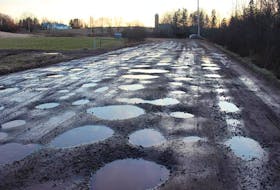Many of you will have known or heard of Will R. Bird.
He was a prolific local writer and author of many novels with a local historic theme.
My favourite - and closely related to the main theme of this article - is The Passionate Pilgrim. He wrote and published thousands of articles for various magazines. He loved local history and wrote A Century At Chignecto.
Dr. Bird( he was awarded several honourary doctor's degrees) was born in Mapleton but spent most of his writing years in Amherst. For many years he was the manager of the Provincial Tourist Bureau at Fort Lawrence.
I had the pleasure of meeting him on two occasions. He spent his retirement years in Halifax. In the mid-70s, the Amherst Chamber Of Commerce honoured him with its Honourary Citizen Award.
In 1959, Dr. Bird published a book entitled These Are The Maritimes. It is a travelog in which he described the special sights, people and stories he and his wife encountered as they travelled the roads of all three of the Maritime Provinces.
The book is out of print and a bit dated, of course, but still very informative and enjoyable to read. I was reminded of this book as I lead a local tour a few weeks ago as part of a Tantramar Seniors' College course on two famous local men: Col. William Frederick Wallet DesBarres and Amos Peck Seaman.
DesBarres (1721-1824) wasn't really local. He was born in France, served with the British Forces in New York , Louisbourg and Quebec City and spent many years surveying the coast of North America and in England.
However, he was also Lt. Governor of Cape Breton and Prince Edward Island. He acquired huge swatches of land in Falmouth and Tatamagouche. More importantly, he purchased and settled many thousands of acres at Nappan, Maccan and Minudie.
DesBarres is an extremely interesting historical figure. Much has been written about him and his greatest accomplishment - The Atlantic Neptune. The most enjoyable portrayal of the man and his times is offered by Will R. Bird's book: An Earl Must Have A Wife.
So, as our seniors' college group gathered at the Amherst campus of the NSCC, I explained that we may well be standing on land at one time owned by Colonel DesBarres as part of his huge Nappan/Maccan holdings. After all, at that time (around 1800) Amherst was only a village and would certainly not have extended south of Dickey Brook.
I also thought it relevant to point out that the entire tour would be taking place on land at one time owned by DesBarres and later by Amos "King" Seaman. As we drove along the road at Amherst Point we stopped and looked west at the great expanse of the Elysian Fields, which we were to visit.
Then, as the paved road takes a 90-degree turn and the old Amherst Point road continues straight towards and through the marshes of Amherst Point proper, I pointed out that that was the road to the Minudie ferry, which carried people and horses regularly across the River Hebert to Minudie for over 200 years.
Amos Seaman was the first to have bridges constructed across the Maccan River and the River Hebert in about 1823. I told my tour group to slow down as we crossed the present highway bridges spanning the two tidal rivers and take note of their formidable width and typical Bay of Fundy characteristics. What a feat it must have been to build bridges there almost 200 years ago. At River Hebert we turned right and northerly towards Historic Minudie, as a large sign proclaims and invites.
After passing the last hill at Barronsfield we slowed our vehicles to absorb the Minudie panorama – to me as attractive and appealing as that of the better-known Mahone Bay – three white buildings in a row; two churches and a schoolhouse, the cupola of which held one of the three Seaman bells at one time.
Soon after we slowed down again to observe a large cross and a plaque, readable from the stopped vehicle. It commemorates the first European settlers of the area: Acadians, who came to Minudie in 1672 or shortly after.
Next we stopped at the home of the late Ruth Symes, who lived in what is known as the Amos Thomas Seaman House for 96 years of her life. Ruth was the great-granddaughter of Amos ‘King’ Seaman and the last of his descendants to live in Minudie.
She died in 2016, and now the house stands empty, waiting for it to be preserved. It is the last of the many big homes Amos Seaman built for his children.
From that location I was able to point to the grove of huge elms next to the bank of the river , where Seaman's Georgian mansion stood until about 1960 and from which he directed his considerable commercial empire.
Also across the highway from Ruth's house, at the edge of the river, stood the huge Seaman warehouses, the wharf and wharf buildings and the shipyard.
From there Seaman exported hay, lumber and various agricultural products with his fleet of ships
(some of which he had built in Minudie) to the Boston States, the West Indies and even to England.
Eventually, grindstones of various sizes and for various uses, manufactured in his own quarries, became the primary cargo. On the return voyages, the Seaman ships brought dry goods, various manufactured products and household goods from New England and Great Britain.
For that reason it has been said that at one time the people of Amherst travelled to Minudie to shop. There is no doubt that the merchants of Amherst got their supplies at the Seaman warehouses.
There is a story as to how Robb Engineering got statred. The Seaman schooners brought different models of cast-iron stove from Boston and New York. Two brothers by the name of "Robb" decided to peddle these new products from door to door all over the countryside.
They were so successful that they decided to manufacture these stoves themselves. Robb's Foundry was established, later to become Robb Engineering and Dominion Bridge.
There is very little evidence of all that enterprise now at the shores of the River Hebert. We were not able to venture to the water's edge, because of the condition of the old road. The location of the docks is barely visible.
In past years, a series of panels explained the location of the structures and history. They were not there at the time of our visit. Amos ‘King’ Seaman became a very wealthy and famous character.
Minudie grew with him, by leaps and bounds. It is no more. Now, when you stand on the front lawn of the Amos Thomas Seaman house, as we did and look down on the ever-widening mouth of the River Hebert, you no longer can expect to see the sails of Seaman schooners returning from a profitable trip. Instead, a new landmark fills the view: the battery of windmills at West Amherst. By this time we had had only made one real stop, which had required us to leave our vehicles.
Unfortunately, it was a cool and drizzly day, but the spell of history made it easy to ignore the poor weather conditions.
We made three more stops after that, but I will need to cover those in Part 2. Please wait until then before you decide to undertake a Minudie tour. The weather will be better and the school museum may be open by then. But--- the Minudie mosquitoes! I'll will explain.
Morris Haugg is a member of the Amherst News Community Editorial Panel.









